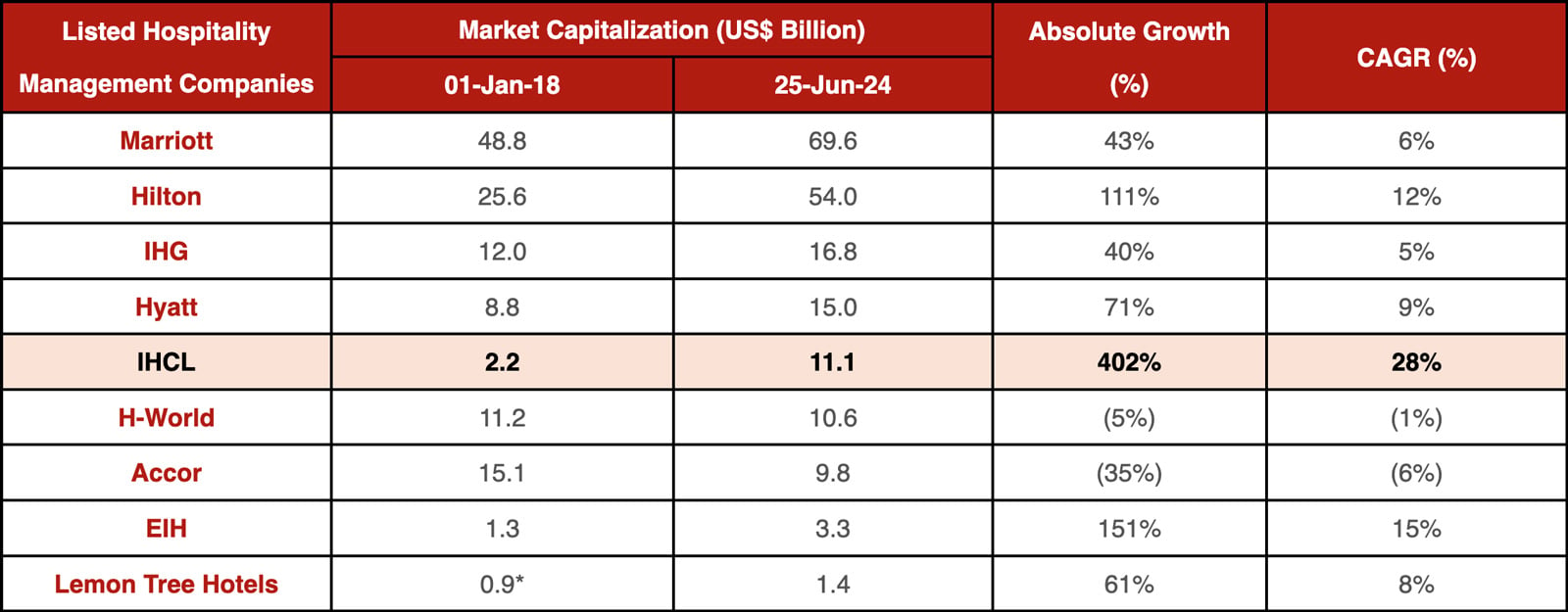HVS Monday Musings: Hotel Sector’s Big Debate - Asset Light or Asset Right?
The Indian Hotels Company Limited (IHCL) has recently been making significant strides in the global hospitality industry. With Brand Finance ranking Taj as the world's strongest hotel brand for the third time recently, and the remarkable growth in the company’s market capitalization, IHCL's ascent into the Top 5 global Hotel Management companies (by market cap) is a testament to its growing global presence and influence. This recognition not only highlights IHCL's success but also places the Indian hospitality market in the global spotlight in line with the country’s ascent among the top 5 global economies.
IHCL's Market Cap Growth
According to recent data from S&P Capital IQ, IHCL's market capitalization surged from US$2.2 billion on January 1, 2018, to US$11.1 billion on June 25, 2024. This staggering 402% absolute growth is the highest among its global peers, and the CAGR of 28% far surpasses the growth rates of other leading hospitality management companies.
Maturing of the Indian Hospitality Stock Market
IHCL's extraordinary growth reflects a broader trend in the maturing Indian hospitality stock market, where well-entrenched players are increasingly valued for their stability and growth potential. This maturation is occurring alongside an exponential growth opportunity within India, highlighting the potential for significant returns on investment in the sector.
Additionally, this growth also opens up a broader discussion about strategic models in the hospitality industry, particularly the Asset Light and Asset Right models. The Asset Light model, which has been widely adopted by most global hotel management chains, focuses on operating hotels through management or franchise agreements rather than owning the properties. On the other hand, the Asset Right model advocates for a balanced approach, combining owned and managed properties. This model is particularly relevant for markets in early growth stages, like India, where owning strategic assets can provide more control over brand standards, allows direct participation in government-auctioned marquee assets, and potentially higher profitability.
While the Asset Light model offers scalability and flexibility, the Asset Right model ensures a strong foothold in key markets and a proficient utilization of internal accruals as the balance sheet size grows. A balanced growth strategy that incorporates both equity and debt capital to own part of the inventory, especially in prime locations or marquee assets, can provide these companies with a more robust foundation for sustainable growth. This approach allows companies to leverage the benefits of ownership while maintaining the flexibility needed to adapt to changing market conditions. It also fosters a culture that allows for more prudent cost management that can be effectively leveraged while managing non-owned assets, providing greater comfort to asset owners of expenses being measurable identically for owned and managed assets.
As the Indian hospitality sector evolves, the ongoing debate between Asset Light and Asset Right models will continue to shape the strategies of major players, as the dynamic nature of the sector requires strategic flexibility and robust growth models that can capitalize on emerging opportunities and ensure long-term success.

